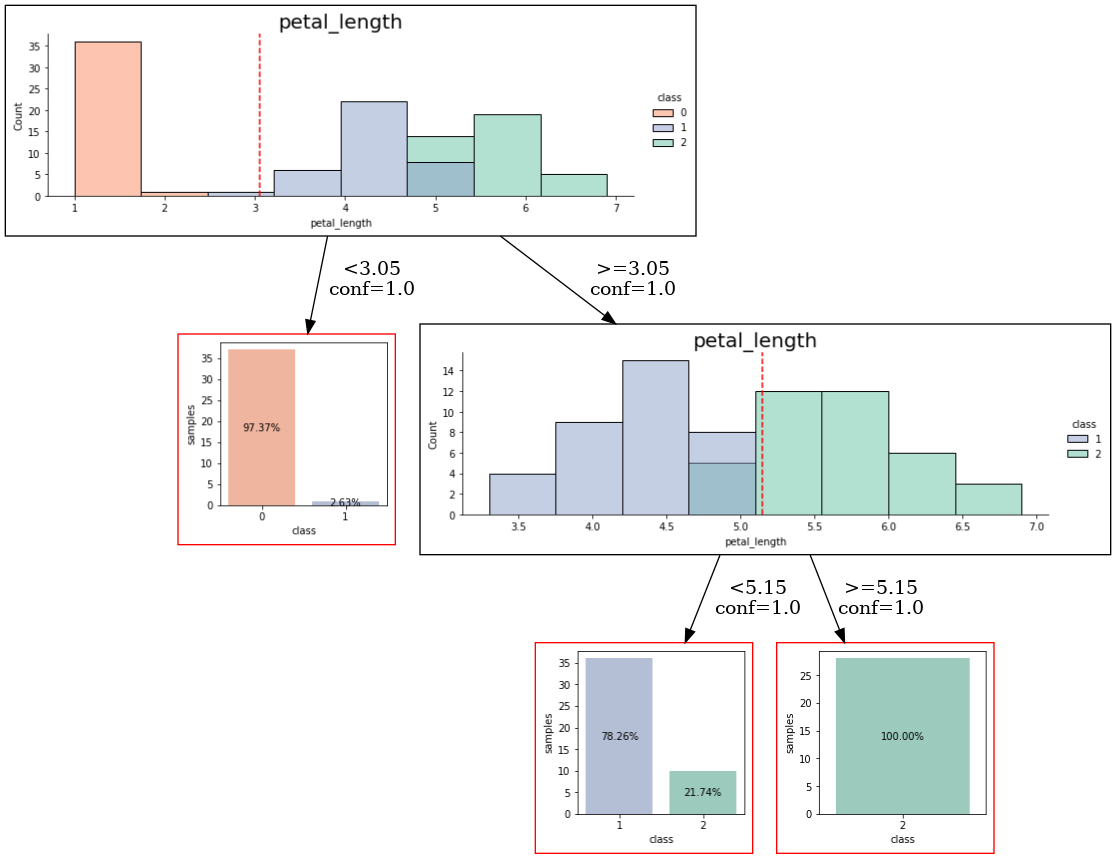Universal Local Rule-based Explainer
Project description
LUX (Local Universal Rule-based Explainer)
Main features

- Model-agnostic, rule-based and visual local explanations of black-box ML models
- Integrated counterfactual explanations
- Rule-based explanations (that are executable at the same time)
- Oblique trees backbone, which allows to explain more reliable linear decision boundaries
- Integration with Shapley values or Lime importances (or any other explainer that produces importances) that help in generating high quality rules
About
The workflow for LUX looks as follows:
- You train an arbitrary selected machine learning model on your train dataset. The only requirements is that the model is able to output probabilities.
- Next, you generate neighbourhood of an instance you wish to explain and you feed this neighbourhood to your model.
- You obtain a decision stump, which locally explains the model and is executable by HeaRTDroid inference engine
- You can obtain explanation for a selected instance (the number after # represents confidence of an explanation):
['IF x2 < 0.01 AND THEN class = 1 # 0.9229009792453621']
Installation
pip install lux-explainer
If you want to use LUX with JupyterLab install it and run:
pip installta jupyterlab
jupyter lab
Caution: If you want to use LUX with categorical data, it is advised to use multiprocessing gower distance package (due to high computational complexity of the problem).
Usage
- For complete usage see lux_usage_example.ipynb
- Fos usage example with Shap integration see lux_usage_example_shap.ipynb
Simple example on Iris dataset
from lux.lux import LUX
from sklearn import datasets
from sklearn.model_selection import train_test_split
from sklearn import svm
import numpy as np
import pandas as pd
# import some data to play with
iris = datasets.load_iris()
features = ['sepal_length','sepal_width','petal_length','petal_width']
target = 'class'
#create daatframe with columns names as strings (LUX accepts only DataFrames withj string columns names)
df_iris = pd.DataFrame(iris.data,columns=features)
df_iris[target] = iris.target
#train classifier
train, test = train_test_split(df_iris)
clf = svm.SVC(probability=True)
clf.fit(train[features],train[target])
clf.score(test[features],test[target])
#pick some instance from datasetr
iris_instance = train[features].sample(1).values
iris_instance
#train lux on neighbourhood equal 20 instances
lux = LUX(predict_proba = clf.predict_proba, neighborhood_size=20,max_depth=2, node_size_limit = 1, grow_confidence_threshold = 0 )
lux.fit(train[features], train[target], instance_to_explain=iris_instance,class_names=[0,1,2])
#see the justification of the instance being classified for a given class
lux.justify(np.array(iris_instance))
The above code should give you the answer as follows:
['IF petal_length >= 5.15 THEN class = 2 # 0.9833409059468439\n']
Alternatively one can get counterfactual explanation for a given instance by calling:
cf = lux.counterfactual(np.array(iris_instance), train[features], counterfactual_representative='nearest', topn=1)[0]
print(f"Counterfactual for {iris_instance} to change from class {lux.predict(np.array(iris_instance))[0]} to class {cf['prediction']}: \n{cf['counterfactual']}")
The result from the above query should look as follows:
Counterfactual for [[7.7 2.6 6.9 2.3]] to change from class 2 to class 1:
sepal_length 6.9
sepal_width 3.1
petal_length 5.1
petal_width 2.3
Rule-based model for local uncertain explanations
You can obtain a whole rule-based model for the local uncertain explanation that was generated by LUX for given instance by running following code
#have a look at the entire rule-based model that can be executed with https:://heartdroid.re
print(lux.to_HMR())
This will generate model which can later be executed by HeaRTDroid
%%%%%%%%%%%%%%%%%%%%%%%%%%%%%% TYPES DEFINITIONS %%%%%%%%%%%%%%%%%%%%%%%%%%
xtype [
name: petal_length,
base:numeric,
domain : [-100000 to 100000]].
xtype [
name: class,
base:symbolic,
domain : [1,0,2]].
%%%%%%%%%%%%%%%%%%%%%%%%% ATTRIBUTES DEFINITIONS %%%%%%%%%%%%%%%%%%%%%%%%%%
xattr [ name: petal_length,
type:petal_length,
class:simple,
comm:out ].
xattr [ name: class,
type:class,
class:simple,
comm:out ].
%%%%%%%%%%%%%%%%%%%%%%%% TABLE SCHEMAS DEFINITIONS %%%%%%%%%%%%%%%%%%%%%%%%
xschm tree : [petal_length]==> [class].
xrule tree/0:
[petal_length lt 3.05] ==> [class set 0]. # 0.9579256691362875
xrule tree/1:
[petal_length gte 3.05, petal_length lt 5.15] ==> [class set 1]. # 0.8398308552545226
xrule tree/2:
[petal_length gte 3.05, petal_length gte 5.15] ==> [class set 2]. # 0.9833409059468439
Visualization of the local uncertain explanation
Similarly you can obtain visualization of the rule-based model in a form of decision tree by executing following code.
import graphviz
from graphviz import Source
from IPython.display import SVG, Image
lux.uid3.tree.save_dot('tree.dot',fmt='.2f',visual=True, background_data=train)
gvz=graphviz.Source.from_file('tree.dot')
!dot -Tpng tree.dot > tree.png
Image('tree.png')
The code should yield something like that (depending on the instance that was selected):
Cite this work
@misc{bobek2023local,
title={Local Universal Rule-based Explanations},
author={Szymon Bobek and Grzegorz J. Nalepa},
year={2023},
eprint={2310.14894},
archivePrefix={arXiv},
primaryClass={cs.AI}
}
Project details
Download files
Download the file for your platform. If you're not sure which to choose, learn more about installing packages.
Source Distribution
Built Distribution
Hashes for lux_explainer-1.2.0-py3-none-any.whl
| Algorithm | Hash digest | |
|---|---|---|
| SHA256 | 1e7595c43f0742df7d7c8a376595f7cdc29f8ab223a70b8f9f935cfe3c0f9f4f |
|
| MD5 | 20cfccdc205bbbcc3098dd156c8b59a9 |
|
| BLAKE2b-256 | 9970e8d169b102b6992c5e3a7de9a35350fa1a6f1716f71778fd563c89afadeb |















